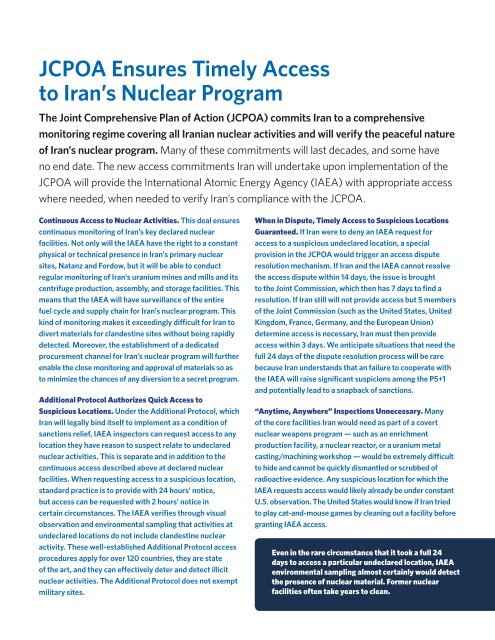WHAT YOU NEED TO KNOW ABOUT THE JCPOA
jcpoa_what_you_need_to_know
jcpoa_what_you_need_to_know
- No tags were found...
You also want an ePaper? Increase the reach of your titles
YUMPU automatically turns print PDFs into web optimized ePapers that Google loves.
<strong>JCPOA</strong> Ensures Timely Accessto Iran’s Nuclear ProgramThe Joint Comprehensive Plan of Action (<strong>JCPOA</strong>) commits Iran to a comprehensivemonitoring regime covering all Iranian nuclear activities and will verify the peaceful natureof Iran’s nuclear program. Many of these commitments will last decades, and some haveno end date. The new access commitments Iran will undertake upon implementation of the<strong>JCPOA</strong> will provide the International Atomic Energy Agency (IAEA) with appropriate accesswhere needed, when needed to verify Iran’s compliance with the <strong>JCPOA</strong>.Continuous Access to Nuclear Activities. This deal ensurescontinuous monitoring of Iran’s key declared nuclearfacilities. Not only will the IAEA have the right to a constantphysical or technical presence in Iran’s primary nuclearsites, Natanz and Fordow, but it will be able to conductregular monitoring of Iran’s uranium mines and mills and itscentrifuge production, assembly, and storage facilities. Thismeans that the IAEA will have surveillance of the entirefuel cycle and supply chain for Iran’s nuclear program. Thiskind of monitoring makes it exceedingly difficult for Iran todivert materials for clandestine sites without being rapidlydetected. Moreover, the establishment of a dedicatedprocurement channel for Iran’s nuclear program will furtherenable the close monitoring and approval of materials so asto minimize the chances of any diversion to a secret program.Additional Protocol Authorizes Quick Access toSuspicious Locations. Under the Additional Protocol, whichIran will legally bind itself to implement as a condition ofsanctions relief, IAEA inspectors can request access to anylocation they have reason to suspect relate to undeclarednuclear activities. This is separate and in addition to thecontinuous access described above at declared nuclearfacilities. When requesting access to a suspicious location,standard practice is to provide with 24 hours’ notice,but access can be requested with 2 hours’ notice incertain circumstances. The IAEA verifies through visualobservation and environmental sampling that activities atundeclared locations do not include clandestine nuclearactivity. These well-established Additional Protocol accessprocedures apply for over 120 countries, they are stateof the art, and they can effectively deter and detect illicitnuclear activities. The Additional Protocol does not exemptmilitary sites.When in Dispute, Timely Access to Suspicious LocationsGuaranteed. If Iran were to deny an IAEA request foraccess to a suspicious undeclared location, a specialprovision in the <strong>JCPOA</strong> would trigger an access disputeresolution mechanism. If Iran and the IAEA cannot resolvethe access dispute within 14 days, the issue is broughtto the Joint Commission, which then has 7 days to find aresolution. If Iran still will not provide access but 5 membersof the Joint Commission (such as the United States, UnitedKingdom, France, Germany, and the European Union)determine access is necessary, Iran must then provideaccess within 3 days. We anticipate situations that need thefull 24 days of the dispute resolution process will be rarebecause Iran understands that an failure to cooperate withthe IAEA will raise significant suspicions among the P5+1and potentially lead to a snapback of sanctions.“Anytime, Anywhere” Inspections Unnecessary. Manyof the core facilities Iran would need as part of a covertnuclear weapons program — such as an enrichmentproduction facility, a nuclear reactor, or a uranium metalcasting/machining workshop — would be extremely difficultto hide and cannot be quickly dismantled or scrubbed ofradioactive evidence. Any suspicious location for which theIAEA requests access would likely already be under constantU.S. observation. The United States would know if Iran triedto play cat-and-mouse games by cleaning out a facility beforegranting IAEA access.Even in the rare circumstance that it took a full 24days to access a particular undeclared location, IAEAenvironmental sampling almost certainly would detectthe presence of nuclear material. Former nuclearfacilities often take years to clean.


